Flaminal® Hydro/Forte
Flaminal®
Hydro/Forte
What is Flaminal®?
Flaminal® is a primary wound dressing for the treatment of acute and chronic wounds, infected wounds* or wounds at risk of infection.
Flaminal® has two formulations to manage exudate levels effectively:
-
Flaminal® Hydro for slightly to moderately exuding wounds
-
Flaminal® Forte for moderately to highly exuding wounds
* Under medical supervision only
How does Flaminal® work?

Debriding action
Flaminal® dissolves necrotic tissue and fibrinous attachements, due to its autolytic debridement properties. 1,4

Absorbent alginate
Flaminal® absorbs excess exudate.

Antimicrobial enzyme system
Flaminal® protects against infections and biofilm formation. 1,4
Advanced wound care dressing
Flaminal® contains a unique antimicrobial enzyme system that supports the natural wound-healing process without impeding fibroblast and keratinocyte growth.
It effectively destroys microbes within Flaminal®'s matrix and reduces bacterias released from biofilms, with no evidence of antimicrobial resistance to date.1,5 The alginate absorbs excess exudate, maintaining the ideal moisture balance for moist-wound healing.
Flaminal® continuously debrides the wound.
Benefits of Flaminal®
Why use Flaminal®?
-
Versatile: suitable for a wide range of wound types and shapes.
-
Time-saving: replaces the need for multiple products, saving time for healthcare professionals.
-
Comprehensive: addresses all aspects of the TIMES wound assessment, including infection treatment and prevention.*
-
Promotes healing: supports faster wound healing.
-
All age groups: suitable for all age groups.
-
Atraumatic: enables painless dressing changes.
-
Safe: non-toxic to healthy skin cells and wound tissue.
-
Easy to use: easy to apply and suitable for self-management of certain wounds.
* Under medical supervision only
What makes Flaminal® different?
-
Flaminal® combines an absorbent alginate with an antimicrobial enzyme system. 1,3
-
The antimicrobial action of Flaminal® only takes place in the gel matrix, not on the wound bed. The enzyme system “kills” the bacteria that are absorbed in the gel matrix. 1
-
Flaminal® ensures optimal wound conditions and supports wound healing from the start of treatment. 2
Discover the versatility of Flaminal® in wound care
Flaminal® is a versatile treatment for various wound types, sizes, shapes, and conditions, effective across all healing phases.
Learn about Flaminal®'s antimicrobial protection
Flaminal® is an advanced, non-cytotoxic wound dressing that provides antimicrobial protection for wound healing with no recorded cases of AMR to date.1,5
Learn about Flaminal®'s easy application
Flaminal® provides continuous, effective care without product changes, with easy application and suitability for shared care to ensure uninterrupted healing.
How to apply

Step 1
Clean the wound following local protocols.
Choose which Flaminal® to start with according to exudate levels.
Use Flaminal® Hydro on slightly to moderately exuding wounds, Flaminal® Forte on moderately to highly exuding wounds.

Step 2
Apply Flaminal® covering the entire wound bed with a sufficiently thick layer (e.g. 4-5mm).

Step 3
Cover Flaminal® with the appropriate secondary dressing according to exudate levels.
Frequency of dressing change
The dressing with Flaminal® can remain in place as long as the gel structure is intact (1 to 4 days, depending on the amount of exudate).
Case reports - What is Flaminal® used for
Flaminal® can be used for a variety of wound types.
Discover the difference between Flaminal® Hydro and Flaminal® Forte
Flaminal® comes in 2 formulations and different sizes
Flaminal® is a primary wound dressing, available in a variety of sizes and in two different formulations: Flaminal® Hydro and Flaminal® Forte.
This is to ensure Flaminal® can be adapted to patient needs with regards to exudate levels, and the amount of product required for treatment.
Flaminal® Hydro
Lower Aginate Content
For slightly to moderately exuding wounds
| Pack Size | Order code |
|---|---|
5x15g | 1013-1 |
1x50g | 1021-1 |
500g | 1010-1 |

Flaminal® Forte
Higher Alginate Content
For moderately to highly exuding wounds.
| Pack size | Order code |
|---|---|
5x15g | 1012-1 |
1x50g | 1015-1 |
500g | 1016-1 |

Additional resources
FAQ
Flaminal® (Hydro or Forte) tubes and jars can be used until there expiry date. The expiry date (USE BY: Year/Month) is the last day of the indicated month and year. Once opened, and if recapped carefully, a tube of Flaminal® can be stored at room temperature for 12 months. A jar of Flaminal® 500g however can be used for one week after its first opening.
- Flaminal® Forte and Flaminal® Hydro should be used for moist wound healing, to treat acute or chronic wounds that have breached the dermis.
- Flaminal® Forte contains a larger amount of alginate and should be used on moderately to highly exuding wounds
- Flaminal® Hydro contains less alginate and should be used on slightly to moderately exuding wounds.
- Irrigate and clean the wound and the surrounding area thoroughly.
- Apply a thick layer (e.g. 4-5mm) of Flaminal®(Hydro or Forte).
- Cover with a secondary dressing.
- Renew Flaminal® (Hydro & Forte) whenever the gel structure is no longer intact (1-4 days, depending on the amount of exudate). The wound bed should be irrigated and cleaned with every dressing change. Make sure the remaining of Flaminal® (Hydro & Forte) are removed.
- Initially the wound may appear larger; this is a normal consequence of the debriding action of Flaminal®(Hydro & Forte) which causes dead tissue, dirt and exsudate to be absorbed.
- The colour of the alginates (gel) may change slightly due to their natural origin. Colour changes have no effect on the quality of Flaminal® (Hydro or Forte).
- Dry wax-like flakes (flakes of alginates) may be seen. This is OK if they are found on the wound borders as they will protect the wound from maceration.
- If the flakes appear in the wound itself, particularly with Flaminal® Forte, it might be because the wound is not producing enough exudate and you should change to Flaminal® Hydro. These flakes should be removed. Flakes of alginate are water soluble, thus can be removed easily with water.
The wound is too wet for Flaminal® Hydro and should be replaced with Flaminal® Forte, which is more absorbent. Ensure the secondary dressing is absorbent.
Flaminal® contains two enzymes, glucose oxidase and lactoperoxidase. Glucose oxidase converts the available glucose, oxygen and water into peroxide ions. Lactoperoxidase converts the peroxide ions into reactive oxygen species. The reactive oxygen species created will destroy bacteria that are absorbed within the Flaminal® matrix. The antimicrobial mode of action of Flaminal only takes place in the matrix.
Sources
- De Smet, K. et al. Pre-clinical evaluation of a new antimicrobial enzyme for the control of wound bioburden. Wounds. 2009, 21(3): 65 - 73.
- Jones, J. et al. TIME to assess wounds - a clinical evaluation of FLAMINAL® (ZEIT für die Bewertung von Wunden - eine klinische Evaluierung von FLAMINAL®) Wounds UK. 2018, 14(3): 63 - 69.
- White, R, Linssen, E: Wundbettvorbereitung, T.I.M.E. und ein Enzym-Alginogel: Literaturübersicht und die klinische Praxis. Wund Management 2016, 10(2), 87 - 90.
- Cooper RA (2013) Inhibition of biofilms by glucose oxidase, lactoperoxidase and guaiacol: the active antibacterial component in an enzyme alginogel. Int Wound J 10(6): 630–7.
- Flen Health. Data on File. Internal Report: Evaluation of Fluid Absorption Capacity and Antimicrobial Activity of Aquacel products. 2017.





















